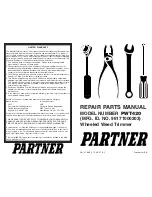
EN - 7
accidental contact with the cutting
means that can cause serious injuries.
I.
Battery backpack
(attachment
on request, par. 15.3): device in
which the batteries are placed.
J. Battery
(attachment on request,
par. 15.1): device that supplies
electric current to the tool.
K.
Battery charger
(attachment on request,
par. 15.2): device used to recharge the
battery; its specifications and regulations
for use are described in a specific manual.
Three battery charger models are available:
K1
(fast battery charge);
K2
(standard
battery charge);
K3
(dual battery charge).
L. Connection cable
: cable used to connect
the machine to the battery backpack.
4. ASSEMBLY
DANGER
The safety regulations to be followed are
described in chapter 2. Strictly comply with these
instructions to avoid serious risks or hazards.
For storage and transport purposes, some
components of the machine are not installed
directly in the factory and have to be assembled
after unpacking. Follow the instructions below.
ATTENTION
Unpacking and completing the assembly
should be done on a flat and stable surface,
with enough space for moving the machine
and its packaging, always making use of
suitable equipment. Do not use the machine
until all the instructions provided in the
“ASSEMBLY” section have been carried out.
4.1 ASSEMBLY COMPONENTS
The packaging includes assembly components.
4.1.1 Unpacking
1.
Carefully open the packaging, paying
attention not to lose components.
2.
Consult the documentation in the
box, including these instructions.
3.
Remove all the unassembled
parts from the box.
4.
Remove the machine from the box.
5.
Dispose of the box and packaging in
compliance with local regulations.
4.1.2
Fitting the battery backpack
The battery backpack is delivered already
assembled (
Fig. 1.I
) and can be released from
the strap support (Fig. 3) and carried by hand.
To release the battery backpack, press
on the two upper buttons (Fig. 3.A).
The battery compartments are located on
both sides of the backpack (Fig. 4).
The following can be found on the
right side of the backpack:
•
cable socket (Fig. 5.A)
•
battery selector (Fig. 5.B)
• one USB port for charging other devices
(e.g. mobile phones) (Fig. 5.C)
To avoid any loose cables, there are
grooves on both sides and at the rear, in
which the power cable can be inserted.
4.2 EXTENSION OF THE
HEDGE TRIMMER
•
Open the lever (Fig. 6.A) following the
direction indicated by the arrow;
• pull or push the rod (Fig. 6.B) until
it reaches the desired length;
•
once the adjustment has been made, close
the lever properly following the direction
indicated by the arrow (Fig. 6.C).
ATTENTION
Periodically check the couplings to
ensure that they are well tightened.
5. CONTROLS
5.1 THROTTLE CONTROL LEVER
The throttle control lever (Fig. 7.A) allows
the start/stop of the cutting means.
The throttle control lever (Fig. 7.A)
can only be operated if the throttle
locking lever is pressed (Fig. 7.B).
5.2 THROTTLE LOCKING LEVER
The throttle locking lever (Fig. 7.B) allows the
throttle control lever to be used (Fig. 7.A).
Summary of Contents for EXPERT SPH 900 AE
Page 4: ...G A D H K1 K2 K3 L E F B C J I 1 2 dB LWA Art N Type s n 2 6 1 4 5 7 3 8...
Page 5: ...A B C 3 5 4 A B A C 6...
Page 6: ...B A C E D B 90 22 A C 7 8 C D B B A 9 10...
Page 7: ...0 15 B A B A 11 12 13 14 15...
Page 8: ...A C B B A 16 17...
Page 34: ...ST S p A Via del Lavoro 6 31033 Castelfranco Veneto TV ITALY dB LWA Type s n Art N...














































